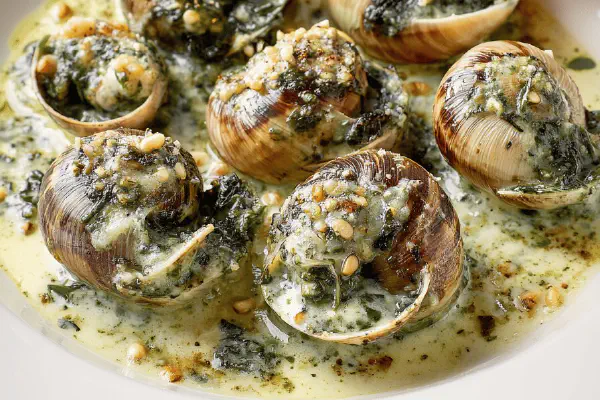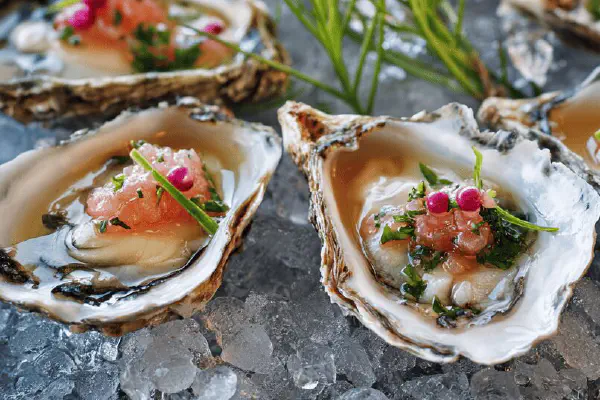Featured Recipe
Maple-Spiced Salmon Gravlax

By Kate
"
Gravlax cured with maple syrup and coarse salt, swapped traditional mustard for horseradish for a sharper kick. Salmon cured in 20 hours, turning firm but silky. Optional horseradish cream balances smoky sweetness with heat. Slightly more salt for proper cure, less syrup to avoid sogginess. Uses center-cut skinless salmon loin. Keep chilled, flip halfway to cure evenly. Quick rinse and blot critical to avoid overly salty surface. Serve paper-thin slices, best on rye or crisp crackers. Can replace cream with Greek yogurt for tang and lighter texture.
"
Prep:
20 min
Cook:
Total:
Serves:
6 servings
salmon
cured fish
Nordic food
appetizer
seafood
Introduction
Maple and salt together draw moisture out, firming salmon while imparting subtle sweetness. Swap traditional mustard for horseradish to sharpen bite and keep the maple from heading too cloying. Curing twenty hours pulls the right moisture—not so firm it’s dry, not soft and raw-fishy. Flipping is crucial: cures evenly through thick center—don’t skip it. Rinsing post-cure removes excess salt and sticky syrup that dull texture and can make slices tough. Can’t find maple? Honey works but reduces complexity. Cream with horseradish lightens texture, kicks heat to brighten rich salmon. For lighter choice, Greek yogurt also works. Keep knife razor sharp. Thin slices. Smells sweet, tangy, sharp, smells like sitting by the wood fire.
Ingredients
Horseradish Cream (optional)
- 80 ml (1/3 tasse) de crème 35 %
- 2,5 ml (1/2 c. à thé) de raifort préparé
- 5 ml (1 c. à thé) de zeste de citron râpé
Extra Twist
About the ingredients
Don’t skimp on salt. Coarse sea salt pulls moisture evenly; too fine will cure too fast and risk toughness. Maple syrup must be pure, not imitation or pancake syrup—real maple adds complex woody notes. Horseradish replaces mustard for sharper, cleaner heat; Dijon or mustard seeds acceptable substitutes but flavour less clean. Zest of lemon wakes flavors and cuts syrup sweetness. Salmon: center-cut loin without skin preferred—skin can interfere with cure absorption; if using skin-on, cure skin down always. For dairy-free, substitute cream with coconut cream or yogurt. Adjust cure salt depending on thickness of fish; thicker needs slightly more salt. The goal is firm but pliable, not raw or cooked. Cure times shift with fridge temp; watch texture not hours blindly.
Method
Cure Mixture and Fish Prep
- In a glass or ceramic dish slightly bigger than the salmon, whisk maple syrup with prepared horseradish and lemon zest until integrated. The acid from lemon zest wakes up maple’s sweetness, keeps flavor bright.
- Pat salmon dry thoroughly, then rub coarse sea salt all over, front and back. Don’t skip drying or salt won’t adhere properly. Place salmon in the dish skin-side down if skin remains, otherwise lay flat. Pour maple-horseradish-zest mix over, smear gently so every surface glistens but not dripping.
- Cover tightly with plastic wrap. Refrigerate 20 hours. Flip at 10 hours to ensure even curing. You want salmon firm but still pliable, not dry or mushy. The salt pulls out moisture, the syrup softens exterior, horseradish cuts sweetness.
- Remove plastic, pour off liquid cure. Rinse lightly under cold water to remove excess salt and sticky syrup that could overpower. Pat fish dry with paper towels — this step prevents over-salting when sliced, and removes residual cure that dulls presentation.
- For cream, whip cold 35% cream just until soft peaks show. Fold in raifort gently. Avoid overwhipping or cream gets grainy. The sharpness balances the rich cured salmon.
- Slice salmon paper-thin across the grain. Use a sharp long-blade knife, slicing in smooth strokes to avoid tearing. Check texture: firm, silky, with slight translucency. Too thick kills elegance, too thin and breaks.
- Serve on rye bread, crisp crackers, or endive leaves. Dollop horseradish cream on top or as a dip. Fresh dill or chives optional for aroma but not necessary.
- If cured fish feels mushy, reduce salt next cure or increase curing time for firmer texture. If too salty, rinse more thoroughly after cure. Maple syrup can burn if brushed on post-cure, so only use in cure.
- No horseradish? Substitute with Dijon mustard or wasabi paste but adjust quantities to taste.
- If pressed for time, minimum 16 hours cure possible but texture less developed. Max 24 hours before salmon starts becoming overly firm.
- The lemon zest addition wakes up the flavor, preventing heaviness from maple and salt.
After Cure
Horseradish Cream
Finish and Serve
Troubleshooting Tips
Technique Tips
Use glass or ceramic dish; metal can react with cure. Mix cure thoroughly so syrup and horseradish combine well. Pat salmon dry—wet fish resists cure absorption and results in uneven texture. Salt rub essential; use your hands, get even coating. Cover tightly to avoid fridge drying. Flip halfway: fish will release moisture, flip to soak both sides evenly or one side overcures. After cure, pour off liquid to avoid overly salty film. Quick rinse then pat fully dry; excess moisture ruins slicing and texture. Cream should be chilled, whipped just to soft peaks for richest mouthfeel with horseradish. Slice against grain, very thin on a sharp knife to prevent shredding. Serve chilled. Canape bases like rye or pumpernickel add earthy counterpoint. Leftover: keep wrapped airtight, 3 days max. Too salty? Slice thin and soak briefly in cold water to draw salt out, then dry.
Chef's Notes
- 💡 Key to salmon curing: don’t skip drying thoroughly. Moist fish prevents salt from adhering. Otherwise, uneven texture.
- 💡 Use coarse sea salt, not fine. Fine salt cures too fast, risk toughness. Good salt pulls moisture evenly, better control.
- 💡 Watch time meticulously. 20 hours is optimal. Shorter can lead to mushiness. But don’t exceed 24 hours or it gets too firm.
- 💡 For best results, quick rinse post-cure critical. Removes excess syrup and salt. Pat dry to avoid overly salty slices later.
- 💡 Experiment with horseradish amounts in the cream. Taste as you fold into whipped cream. Adjust for your bite preference.
Kitchen Wisdom
How do I fix mushy salmon?
Reduce salt next time. Increase curing time too. Aim for firm texture but still pliable.
What if my salmon tastes too salty?
Rinse more thoroughly after curing. Maybe soak slices in cold water briefly.
Can I store leftover gravlax?
Wrap airtight, keep chilled. Should last 3 days max. Careful with moisture away.
What are my options for horseradish?
Substitute with Dijon mustard or wasabi. Adjust taste, balance flavors.



